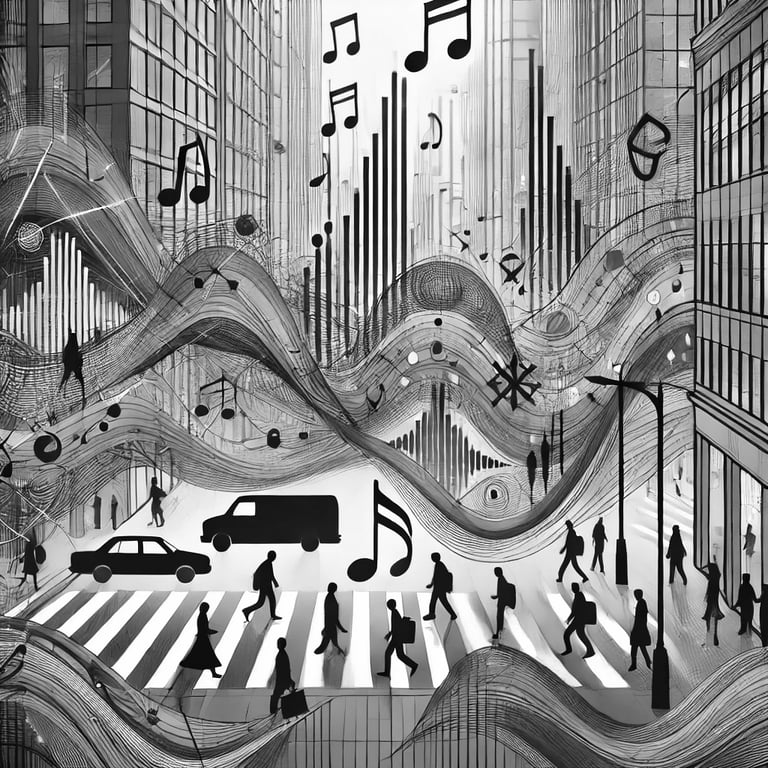The Invisible Art of Sound in Street Photography: Hearing the Streets Through Images
Street photography is, by nature, a silent art. We see the world unfold in frames, capturing moments that reveal the essence of life in a split second. But while the streets are alive with energy and movement, they are also full of sound—the hum of city life, the conversations that drift through the air, the sudden noise that breaks the stillness. Though sound cannot be captured by the lens, it is often felt in the images we create, adding an unseen layer of emotion and context to the photos.
How Sound Shapes Perception
Even though street photography is a visual medium, the viewer’s experience is often colored by their imagination of sound. Think about it: when you see a photograph of someone playing a guitar in a crowded subway station, you almost hear the strum of the strings or the chatter of passersby. When you capture an image of children running across the street, the laughter and shouts seem to echo in your mind. Sound lives in the spaces between the pixels, completing the story the image tells.
While we cannot hear these sounds in the photographs themselves, we instinctively imagine them, adding a rich sensory dimension to the scene. This is the invisible art of sound in street photography—the ability to suggest and evoke sounds through visual cues.
Implying Sound Through Composition
As photographers, we can’t capture sound directly, but we can imply it in creative ways. Here are some techniques for evoking sound in street photography:
Motion and Gesture: The blur of a subway train pulling into the station, a hand raised in greeting, or a child mid-laughter all carry the suggestion of movement and the accompanying sounds. Capturing action at its peak often evokes the noise of the moment—whether it's the rush of air as the train moves or the joyful shouts of children at play.
Framing the Unexpected: Juxtapositions can also imply sound. A man shouting on a street corner, his mouth wide open, caught just as a flock of pigeons takes flight nearby, creates a tension between noise and silence. The viewer imagines the shouts and the sudden flurry of wings, even though the scene is entirely silent.
Stillness as Silence: On the flip side, the absence of motion can suggest silence. A deserted street at dawn, captured in soft light, evokes the stillness of early morning before the world has fully woken up. This quietude contrasts with the usual noise of city life, and the photograph becomes a meditation on silence itself.
The Emotional Power of Implied Sound
Sound in street photography doesn’t just add context—it can change the entire emotional resonance of an image. A photograph of a busy marketplace might feel vibrant and full of life because the viewer imagines the lively chatter and the clatter of stalls. On the other hand, a photo of a lone figure standing in a busy street may evoke a sense of isolation, not just visually but because of the imagined contrast between the noise surrounding them and the quiet in which they stand.
Cinematic Influence: Silent Films and Street Photography
Street photography shares a kinship with silent films, where action and emotion are conveyed without dialogue. In the early days of cinema, directors had to rely heavily on body language, framing, and visual cues to suggest sounds and emotions. Similarly, street photographers can draw inspiration from this silent medium, learning how to imply sound and narrative through the careful use of light, shadow, and timing.
Capturing Soundless Chaos
Think of the chaos of a busy intersection, captured in a single frame. The image alone shows the hustle—buses, cars, bicycles, people crossing from every direction—but the suggestion of honking horns, rushing footsteps, and distant sirens brings the scene to life in the viewer’s mind. The ability to suggest this auditory chaos through composition and timing is a skill that elevates street photography beyond simple documentation.
Why Sound Matters in Street Photography
Ultimately, the role of sound in street photography is about creating a more immersive experience. The street is not just a visual landscape—it is a living, breathing, noisy organism. And while our cameras capture the visual aspect, our minds fill in the blanks with sound, making the image resonate on a deeper, more emotional level.
By being mindful of the sounds that surround you as you shoot, and considering how they might be implied in your compositions, you can create street photographs that engage not just the eye but the imagination. Next time you’re out with your camera, think about the sounds you hear and how they interact with the visuals. Does the scene need a burst of noise? Or does the stillness of silence tell a more powerful story?
As street photographers, we often wait patiently for the perfect moment, but perhaps we should also be listening for the perfect sound. Because when we start to think of street photography not just as a visual medium, but as one that hints at sound, we open ourselves up to a world of new possibilities—moments of humour, chaos, serenity, and everything in between, all playing out in the silent frames we capture.


Copyright © 2025 Peter Pickering. All Rights Reserved. All Wrongs Reversed.
🌐 peterpickering.com | 🎺 sessionsonthegreen.com | 💜 isaacbcole.com | ▶️ YouTube Channel | 🌿 life.peterpickering.com


